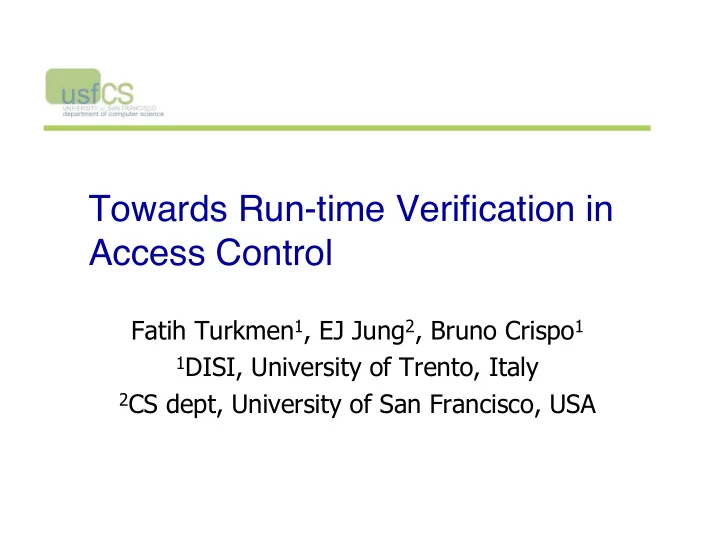

Towards Run-time Verification in Access Control Fatih Turkmen 1 , EJ Jung 2 , Bruno Crispo 1 1 DISI, University of Trento, Italy 2 CS dept, University of San Francisco, USA
Motivation How can we exploit existing software model checking tools that • Allow mimicking RBAC run-time • Support finite/infinite state analysis What concepts/techniques can be borrowed from run-time verification 1 ? 1: http://en.wikipedia.org/wiki/Runtime_verification
Desired properties Mutually Exclusive Roles (MER) • e.g. accountant vs. auditor Separation of Duty (SoD) • e.g. two signatures required for payment over $5K • even static version is co-NP • simulate with MER Conflict of Interest (CoI) • e.g. applicant vs. reviewer All require run-time verification
Example policy Alice is a senior accountant and Bob is a junior accountant at Firm Fermata. An accountant can view and edit his or her clients’ information. An accountant can audit his or her junior accountants’ edits. A junior accountant covers for the senior accountant when the senior is out of office.
Static vs. Dynamic verification Dynamic verification • benefit from all the run-time information – e.g. user name, activated roles, session information, … • imposes overhead on the system – coordination and synchronization over distributed systems is costly Static verification • can use more resource and time • lacks the run-time information
State Explosion Exponential combination of session interleavings Also for all possible values of dynamic info
Static approximates Dynamic Our idea • static approximation of run-time verification • via simulating dynamic simultaneous sessions • similar to approaches in software verification Current status • given the policy, simulate roles and users • adopted simple temporal properties to simulate events • can verify dynamic Mutually Exclusive Roles – thus approximates dynamic Separation of Duty
Scala Actor Framework Event-based • role (de-)activation, permission request: all events • scales well with many actors Thread-based • send/receive requests for role and permission activation Our approach: access control policy is modeled in Scala Actor Framework and treated as “software” that needs verification
Example codes Coordinator Coordinator Authorizer Authorizer def def act(){ def def act(){ authorizer.start initialize var authActorClose: In var Int = 0 while(tr while true){ while while(tr true){ receive{ receive{ case case e: RA => case case s : Session => if if (checkRA(e)) sender ! Permit requestCount(s.getUser.getUserID) else else sender ! Deny if if user is allowed more sessions case case e: PA => s.getUser.addSession if if (checkPA(e)) sender ! Permit s.getUser ! SessionPositive else else sender ! Deny } else else { ca case Stop => s.getUser ! SessionNegative exit() authActorClose = authActorClose + 1 } if if (authActorClose == userNum){ } authorizer ! Stop } exit() } } case case event : PA => User User authorizer ! event def def act(){ receive{ var var session : Session = createSession(generateRoleEntropy) ca case Permit => while while(tr true){ if if (checkConstraints){ receive{ history += event ca case SessionPositive => event.getOwner ! Permit session.start } sessions += session ca case Deny => event.getOwner ! Deny Thread.sleep(random.nextInt(500)) } session = createSession(generateRoleEntropy) case event : RA => case case case SessionNegative => authorizer ! event exit() receive{ } case case Permit => } if if (!checkConstraints){ } history += event event.getOwner ! Permit } case Deny => event.getOwner ! Deny case } } } }
System Architecture Test cases (policies) initiate verification 1. User requests roles and permissions 2. Session information is given to coordinator 3. Coordinator asks Authorizer for decision
User behavior modeling Session creation A R : Activating a Role D R : Deactivating a Role A P : Activation a Permission
Three levels of verification Core simulation • partial simulation without run-time properties • e.g. race conditions, policy conflicts Symbolic evaluation • using some approximations of run-time properties • temporal and location parameters approximated • Monte Carlo simulation of parameters Monitor development • partial step-wise verification at run-time • just-in-time verification using Aspect Oriented Programming
Three levels of verification Core simulation • partial simulation without run-time properties • e.g. race conditions, policy conflicts Symbolic evaluation • using some approximations of run-time properties • temporal and location parameters approximated • Monte Carlo simulation of parameters Monitor development • partial step-wise verification at run-time • just-in-time verification using Aspect Oriented Programming
DMER support example Bob is in charge of Bravo account. Alice is out of office today. Bob covers of Alice today. Bob can audit accounts of Alice’s junior accountants Bob can audit his own account?
How DMER is supported Using Basset and Java Path Finder for verification Constraint: DMER • Given a new role activation request • Compute the intersection of all active roles and • the roles under DMER constraint • If the intersection of two sets is greater than a preset threshold • Deny the new role activation request
How DMER is supported (2) Encode RBAC, properties and the constraint checking function Execute JPF and Basset for state analysis.
How DMER is supported (3) Bob is an Accountant of Bravo account • Bob cannot disable Accountant role on this object Bob requests to activate an Auditor role The activated roles = {Accountant} The roles under constraint = {Accountant, Auditor} The intersection = {Accountant} Threshold = 1 Bob’s request is denied
Extra support Session concurrency • What if Bob logs in on two different computers? • Verification per session is not enough • Simultaneous sessions are evaluated together – if they touch the same object History support • support for Conflict of Interest, Chinese Wall policies • if Bob has been an accountant of this account in the past, then he is not eligible to audit this account
Conclusion and Future work Conclusion • approximate run-time verification in static • can verify dynamic mutual exclusive roles Future work • support for more generic COI • large scale experiments for performance testing
Recommend
More recommend